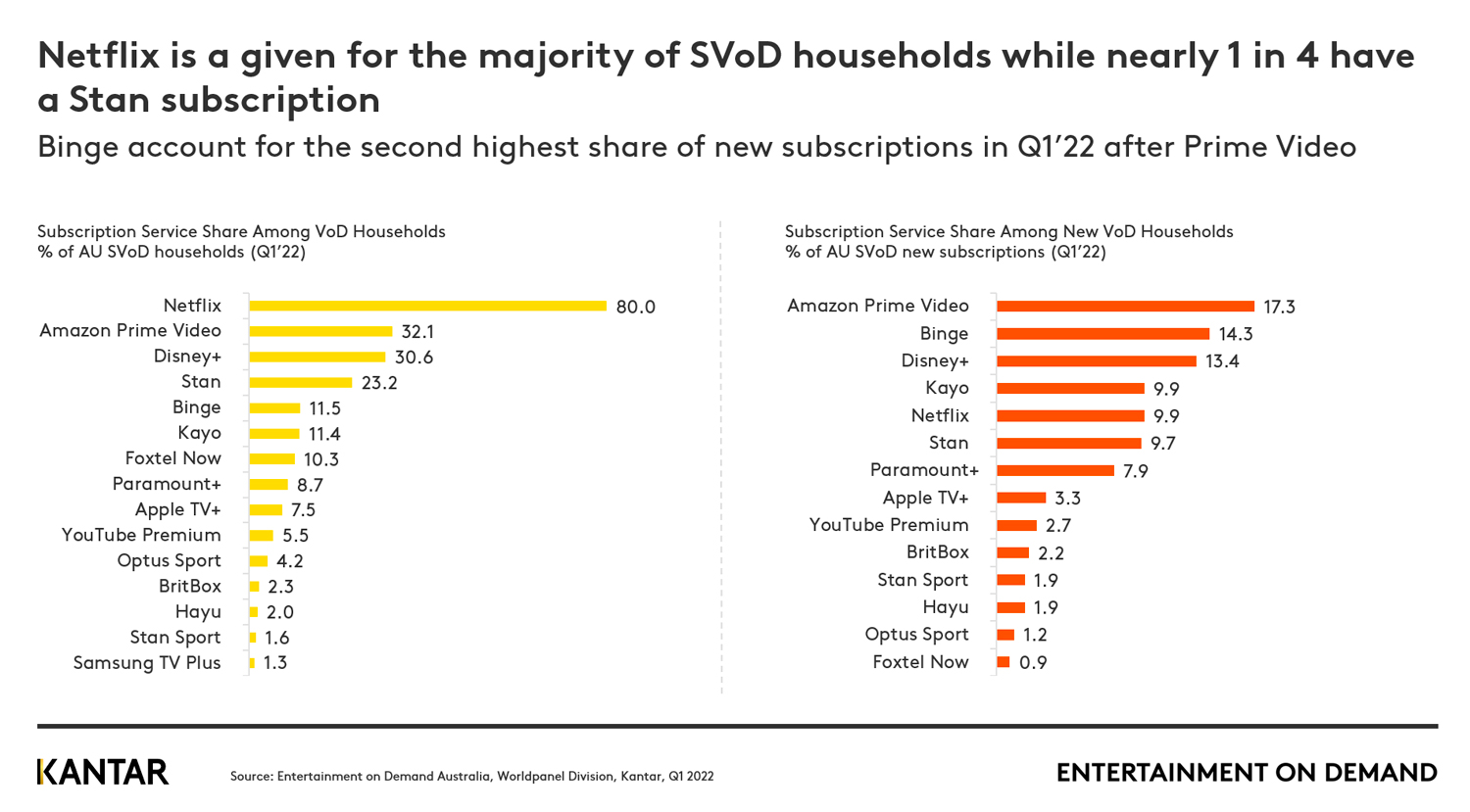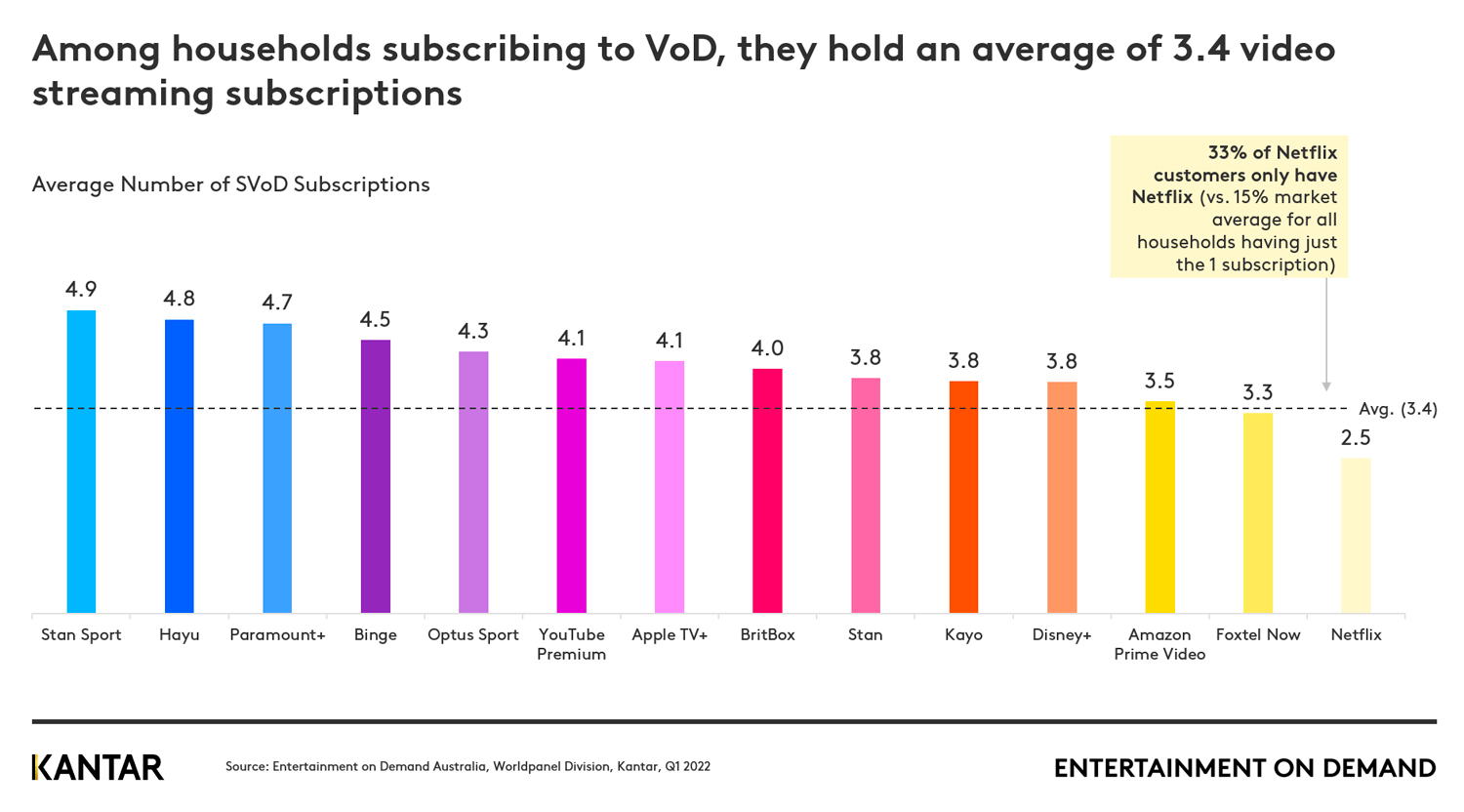We have expanded our Entertainment on Demand service to Australia. Already live in the US, Great Britain, and Germany, the new service provides longitudinal insights across the video and music streaming sectors to platforms, content providers and investors. The quarterly service will track streaming subscriber numbers, shares and content performance, alongside acquisition, usage, engagement and churn. Kantar’s Entertainment on Demand service is used by the world’s largest streaming services to help drive subscriber acquisition, engagement and retention.
Headline results from the launch quarter of the service in Australia are now available:
- Appetite for streaming content is strong, with 6.4 million or 63.8% of Australian households subscribing to at least one video streaming service, higher than in Great Britain and Germany, but some way off the US on 81%.
- 27% of households, or 2.7 million, have access to Pay TV, with over two thirds of these households also having an SVoD service. Those Pay TV customers who have yet to enter the SVOD category skew heavily towards over 45-year-olds and retirees, whilst one third of customers with both Pay TV and SVoD are aged under 35 and are more likely to be male.
- Netflix dominates with 80% of SVoD enabled households accessing the service. Amazon Prime Video and Disney+ take #2 and 3 spots with shares of 32% and 31% respectively.
- Compared to other western markets, local brands do well, showing higher levels of ownership. Stan leads among the local service providers, with its core service present in almost 1 in 4 homes. However, taking the Foxtel streaming brands as a group, 29.7% of SVoD households have at least one of their services in the home.

Over 7% of households signed up to a new video streaming service in Q1 2022, 725,000 in total. Amazon Prime Video accounts for the highest share of new subscriptions this quarter at 17.3%, followed by Binge with 14.3% (driven clearly by Euphoria, which was the most recommended title in Q1 2022), whilst Marvel titles help drive sign-up to Disney+, which accounts for 13.4% of new services.
The research found that the ability to ‘watch content when I want’ and content exclusivity are the top purchase triggers for taking out a new subscription, particularly if signing up to Stan, driven by Yellowstone, or Paramount+ and Binge with the offer of a free trial also drawing customers into the latter two providers. The findings also show that 248,000 new subscriptions were taken out by gateway subscribers, households completely new to the category – Netflix generally has the highest proportion of gateway subscribers at 47%, with friends/family an important source of information prior to sign-up.
In addition to the freedom to ‘watch content when I want’, free trials are the second biggest driver for first time streamers taking out a subscription at 28% of households. Content exclusivity is stated as the key trigger by 20% of gateway subscribers, relatively lower than those who are stacking their subscriptions or those who are lapsed, having dropped out of the category and returned.
Stacking and switching market conditions
A relatively high proportion of new video services are stacked at nearly 40%, with almost 290,000 households adding this new service to their existing subscriptions. The average number of SVoD subscriptions held is 3.4, with Netflix significantly lower than average, whilst Foxtel Now and Amazon Prime Video customers are broadly in line with the market. As a relative newcomer to the market, over half of Paramount+ new subscriptions are stacked, higher than all other service providers, with its 1883 drama series key in driving sign-up. The top marketing touchpoint for Paramount+ is the offer of a free trial.

While some consumers are adding to their SVOD stack, others are switching, with 16% of new subscriptions resulting from cancelling an existing video streaming service – around 1 in 4 Britbox and Paramount+ new customers switched from another service. This relatively high proportion of switchers suggests Australian households will not continue to stack much higher and are already starting to rationalise which subscriptions they really need, rather than just adding new ones incrementally.
Satisfaction drives retention
A good indication of subscribers’ satisfaction with a service and their likelihood of recommending it to others is a net promoter score (NPS). Satisfaction or NPS is highest for Netflix at 36ppts, against a market average of 23ppts. Netflix customers are generally happy with most features of their service, with ease of use, amount of original content and variety of TV series being the top drivers of satisfaction and outperforming the competition. Whilst Squid Game was the biggest title driving sign-up to Netflix, Ozark ranked highest in terms of content most enjoyed, closely followed by Stan’s Yellowstone series. Value for money is the second biggest driver for new customers signing up with Netflix. However, despite a lower-than-average NPS overall, satisfaction with this feature is highest for Amazon Prime Video, likely due in part to it offering multiple services within its subscription, with nearly 30% utilising Amazon Prime Delivery.
There is also a strong link between usage intensity and NPS which, in turn, drives longer term customer retention. Among low users (those using their service for 1-2 days per week), average NPS is just 16ppts compared with a score of 34ppts among those classed as high users (those using their service for 3 or more hours per day). On average, 40% of SVoD subscribers viewing on their TV are classed as low, rising to over 40% if they are Disney+, Binge, Stan or Paramount+ users. In contrast, 1 in 5 SVoD subscribers are defined as high users, with Netflix, Amazon Prime Video and Foxtel Now attracting these consumers, managing to capture a higher proportion of their TV viewing time.
Naturally, the more services that customers subscribe to, the more providers are competing for screen time unless they are perceived as the most important service in a customer’s subscription stack, implying that consumers are less likely to cancel their subscription. 22% of Amazon Prime Video stacked customers state that it is their most important subscription. Whilst this is a higher number than many other providers, it is lower than Netflix and Foxtel Now, where 62% and 41% of their customers respectively rank them as the most important service. However, nearly 30% of Amazon Prime Video’s customers are locked into an annual subscription, reducing the immediate threat of churn.
The research also showed that approximately 4% of all subscribers claim to not use their service at all on any device, with the top reasons being that they have too many subscriptions, and difficulty in finding content that they want to watch. Therefore, it is crucial for service providers to offer customised recommendations to guide customers to the content that will keep them engaged with that platform.
Access the interactive data visualisation for more information or contact our experts.


